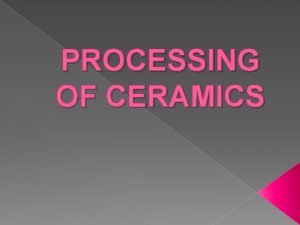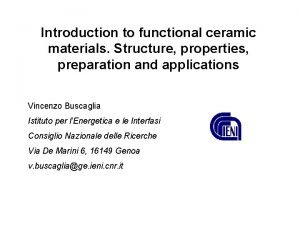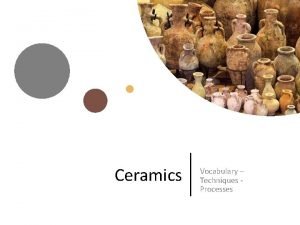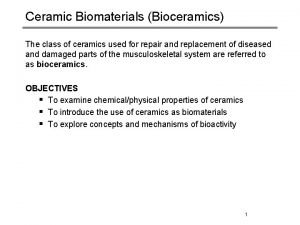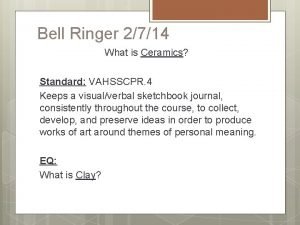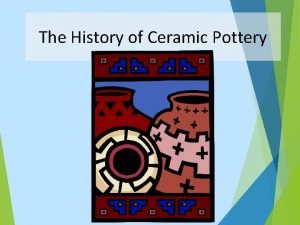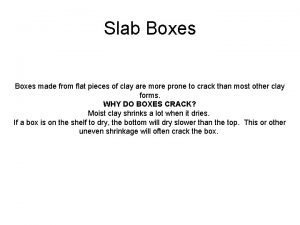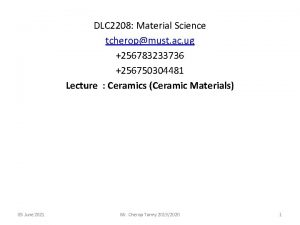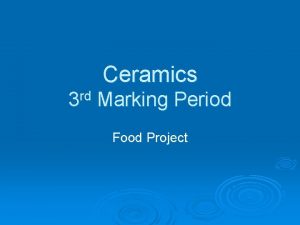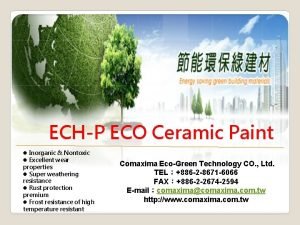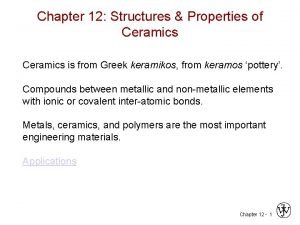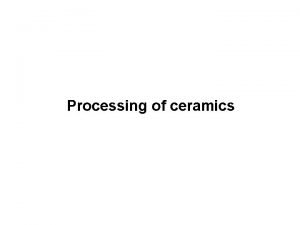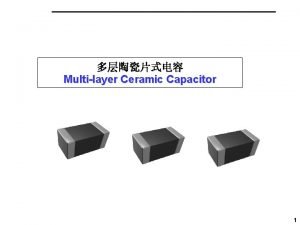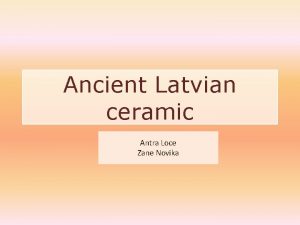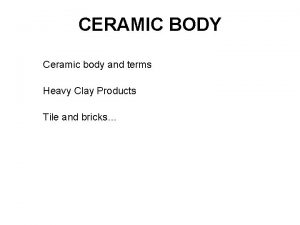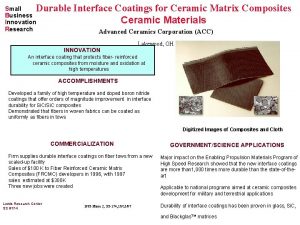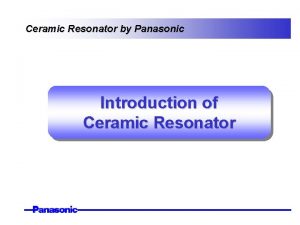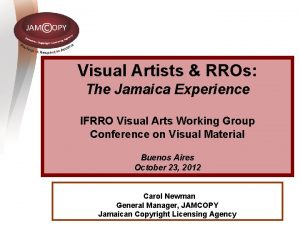CERAMIC ARTISTS HOMEWORK Who is your favorite visual





































- Slides: 37

CERAMIC ARTISTS

HOMEWORK • Who is your favorite visual artist? • BRING me a name of an artist FRIDAY! • You need your sketchbook ASAP! I will check that you have on Tuesday.

BELLWORK On a piece of paper, write three columns: SEE THINK Look at the art. In the chart: List at least three things that you see. Write at least two things that you think. Write one question. Something that you wonder about this piece of art. WONDER

LEARNING ABOUT SCULPTURE • Read and discuss the article.


VICTOR SPINSKI (1940 -2013) • Victor Spinski gained fame through the 1960’s and 70’s. • Spinski was known for his replication of non-ceramic objects with his clay. • Tin buckets, tools, garbage, underwear and paint were favorite subjects and his ceramic pieces reproduced these objects with startling realism. • Technically great and willing to put a great amount of time into his work, Spinski created a new genre of ceramic art. • His work was called trompe l’oiel. Or “fool the eye. ” • He inspired the artist Madeline Levine.



MARIA MARTINEZ (1887 -1990) • Maria Montoya Martinez was a Native American artist who created internationally known pottery. • Martinez, her husband Julian, and other family members examined traditional Pueblo pottery styles and recreated them.



BEATE KUHN (1927 -2015) • Beate Kuhn, born in Düsseldorf in 1927, was one of the most important figures in contemporary German ceramics. • In the 1950 s, Kuhn formed a close working relationship with the ceramists Karl and Ursula Scheid, and founded a workshop community with the married couple. • Kuhn’s work is heavily influenced by nature; the artist has been quoted describing her works as abstract interpretations of naturally occurring forms, rendered dynamically and with intense palette of colors. • She has been known to repeatedly sketch from nature, in order to fully capture the true essence of the natural shapes she features in her ceramics. • Kuhn’s pieces have been exhibited in major museums across the world.



SHIHO KANZAKI (1942 -PRESENT) • He’s been everything from aspiring lawyer to automatic washing machine salesman to master potter. • He was disowned by his father for choosing the potter's wheel over a lawyer's robe. • He was swindled out of getting paid for his work early in his career. • "The truth is, " he said in an interview, "that because of those encounters I am what I am now. The tree that overcomes severe weather reveals its true beauty. It is the same for people. " • Each piece is one of a kind. • Kanzaki fires his half-underground anagama kiln for between 10 -15 days. • All the pots are placed into the kiln unglazed and come out with a natural glaze (shizen-yu) from the flying ashes. The prolonged firing allows for a slow build-up of ash and melted surfaces into undesigned



PETER VOULKOS (1924 -2002) • Peter Voulkos was an American artist of Greek descent. • He is known for his abstract expressionist ceramic sculptures. • He crossed the traditional divide between ceramic crafts and fine art. • His work was shown in prestigious art museums starting in the 60 s.



BEATRICE WOOD (1893 -1998) • Beatrice Wood was an American artist and studio potter. • She was involved in the Avant Garde movement in the United States • She founded The Blind Man magazine in New York City with French artist Marcel Duchamp and writer Henri-Pierre Roché in 1917. • The “mother of dada” • She incorporated eastern philosophy in her art. • Known for pottery with shine or lustre.



BERNARD LEACH (1887 -1979) • British Studio Potter • The father of British Studio Pottery • He was born in Hong Kong and lived there for three years. • He started as an etcher, but was introduced to raku in 1911 • He saw pottery as a combination of art, philosophy, design and craft. • He combined traditional Korean, Japanese, and Chinese pottery with German and English techniques like salt glaze. • He wrote, “A Potter’s Book”



ROBERT ARNESON (1930 -1992) • American sculptor and a professor of ceramics at UC Davis. • Born in Benicia, California • Started a new movement in ceramic art along with other artists called Funk Art. • Instead of making pottery, they made non-functional sculptures that made confrontational statements. • Most of his pieces are like an “autobiography in clay. ” • His most controversial sculpture is a bust of George Moscone.



PAUL SOLDNER (1921 -2011) • From Illinois • He created the American Raku firing technique • He brought abstract expressionism to clay • We served as an army medic during WW 2 and pursued art as a career after the war • He was Peter Voulkos’ first student. • He helped found the Anderson Ranch Art Center in Colorado • Credited with creating the “california school” of ceramics with Voulkos.



ANCIENT GREEKS (8 TH CENTURY- 5 TH CENTURY) • Their pottery is extremely durable and makes good archeological records. • It shapes our understanding of Greek society because of the scenes depicted on the belly of pots. • Greeks loved to paint geometric shapes and their mythology on their vases. • There are over 100, 000 vases from ancient Greece preserved today. • The region of Attica made fine pottery • Most towns had local potters that made functional ware for every day use.



JOMON WARE POTTERY (5, 000 -4, 000 BCE) • The oldest pottery in the world. • Jomon means “rope” patterned/ • Jomon pottery was created by artisans in ancient Japan. • In 1998 46 earthenware fragments were found at Odai Yamamoto and dated as early as 14, 500 BC. • Typically small vessels with round bottoms. • Later pieces were decorated with an impressed rope pattern that got more elaborate as artisans developed.

 Jack prelutsky homework oh homework
Jack prelutsky homework oh homework Homework oh homework i hate you you stink
Homework oh homework i hate you you stink Parts of a poem
Parts of a poem Homework i love you poem
Homework i love you poem Alitteration definition
Alitteration definition Grant always turns in his homework
Grant always turns in his homework Beate kuhn famous artwork
Beate kuhn famous artwork Plastic forming ceramic
Plastic forming ceramic Ceramic matrix composites definition
Ceramic matrix composites definition Functional ceramics application
Functional ceramics application Things made of ceramics
Things made of ceramics Ceramic semiconductor thermometer
Ceramic semiconductor thermometer Phases of composite materials
Phases of composite materials Koptri
Koptri Ceramic matrix composites definition
Ceramic matrix composites definition Pottery vocabulary
Pottery vocabulary Ceramic material structure
Ceramic material structure Ceramic biomaterials
Ceramic biomaterials What is this
What is this Porcelain jacket crown indications
Porcelain jacket crown indications History of clay timeline
History of clay timeline Ceramic slab boxes
Ceramic slab boxes Chemistry cracking
Chemistry cracking Ceramic classification
Ceramic classification Ceramics
Ceramics Die blanks ceramics
Die blanks ceramics Ceramic food project
Ceramic food project Advantages of permanent mould casting
Advantages of permanent mould casting Non toxic ceramic paint
Non toxic ceramic paint Dual inline package use
Dual inline package use Rcation/ranion
Rcation/ranion Ceramic fiber manufacturer
Ceramic fiber manufacturer Ceramic processing upscaling
Ceramic processing upscaling Ceramic processing upscaling
Ceramic processing upscaling Tiles price list
Tiles price list Dominican faceless dolls history
Dominican faceless dolls history Ceramic
Ceramic Mironidis
Mironidis







